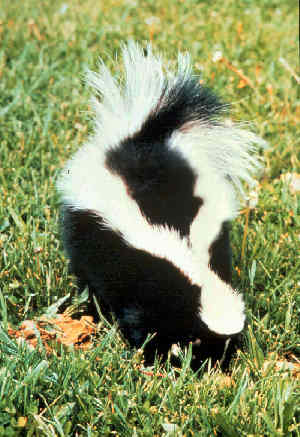Striped Skunk (Mephitis mephitis) - Wiki Striped Skunk
From Wikipedia, the free encyclopedia
The Striped Skunk, Mephitis mephitis, is an omnivorous mammal of the skunk family Mephitidae. Found over most of the North American continent north of Mexico, it is one of the most well-known mammals in Canada and the United States.
The Striped Skunk has a black body with a white stripe along each side of its body; the two stripes join into a broader white area at the nape. Its forehead has a narrow white stripe. About the size of a house cat, it weighs 6 to 14 pounds (2.7-6.3 kg) with a body length (excluding the tail) of 13 to 18 inches (33-46 cm). The bushy tail is 7 to 10 inches long (18-25 cm), and sometimes has a white tip.
The presence of a Striped Skunk is often first made apparent by its odor. It has well-developed anal scent glands (characteristic of all skunks) that can emit a highly unpleasant odor when the skunk feels threatened by another animal.
The skunk is primarily nocturnal. Beginning its search for food shortly after sundown, it feeds on mice, eggs, carrion, insects, grubs, and berries. At sunrise, it retires to its den, which may be in a ground burrow, or beneath a building, boulder, or rock pile. While the male dens by itself, several females may live together. The Striped Skunk does not hibernate.
In February or March, mating occurs, and by early May, after a 63-day gestation, a litter of about five or six young is born. The young are born blind, and follow their mother until late June or July.
The Striped Skunk is beneficial as a consumer of rodent and insect populations, rarely eating farmers' poultry. The species can be domesticated as a pet.
http://en.wikipedia.org/wiki/Striped_skunk
| The text in this page is based on the copyrighted Wikipedia article shown in above URL. It is used under the GNU Free Documentation License. You may redistribute it, verbatim or modified, providing that you comply with the terms of the GFDL. |
